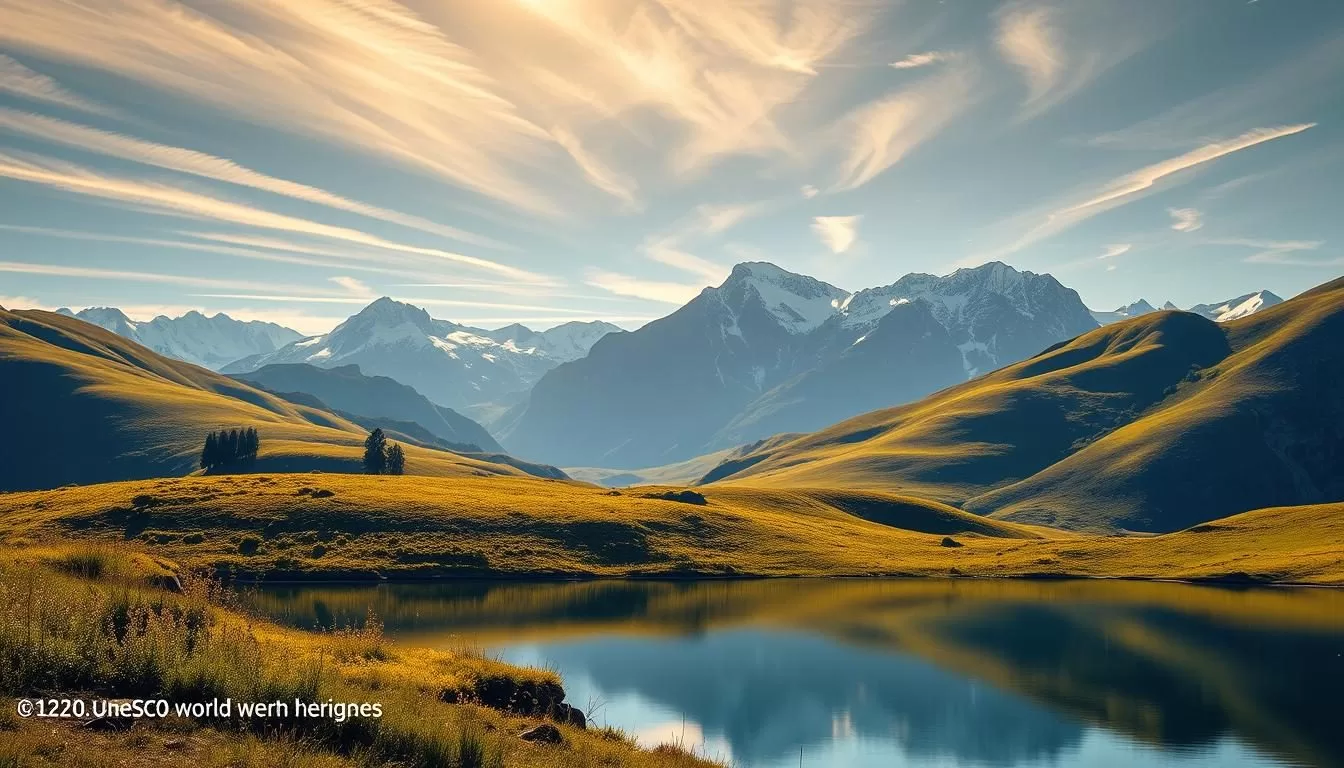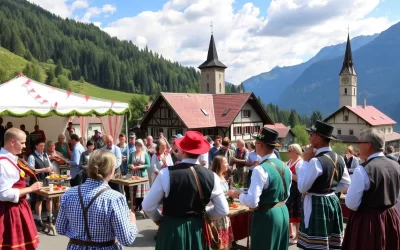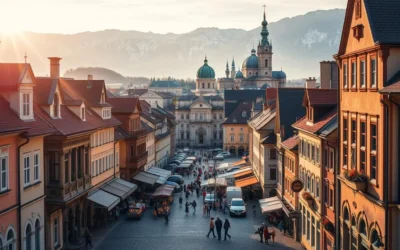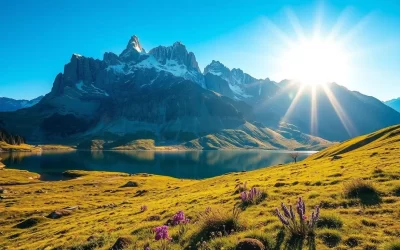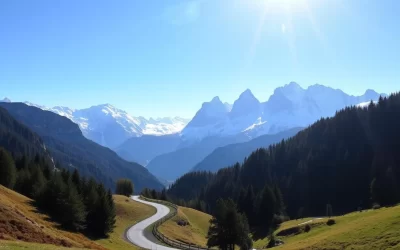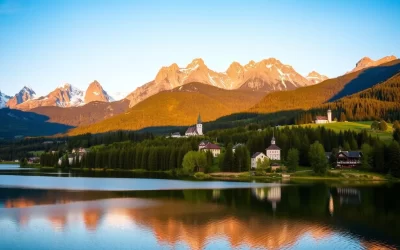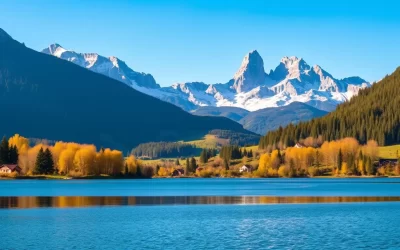✓ Accommodations✓ Flights✓ Rental Cars
Nestled in the heart of the Burgenland wine region, a UNESCO World Heritage site awaits your discovery. Lake Neusiedl, or Neusiedlersee, is a haven for nature lovers, boasting an incredible landscape and home to many species of rare and migratory birds.
At the heart of this haven lies Seewinkel National Park, a paradise for nature enthusiasts. Unlike Austria’s mountainous national parks, this region features flat landscapes with wetlands, salt lakes, and extensive reed beds, creating a unique area teeming with biodiversity.
As you explore this remarkable national park, you’ll discover why it’s a must-visit destination. With its extraordinary biodiversity and unique landscape features, you’ll experience the world heritage site like never before.
Discovering Seewinkel National Park
As you explore Seewinkel National Park, you’ll discover a landscape that is as rich in history as it is in biodiversity. This unique national park is not only a haven for wildlife but also a significant cultural region.
Location and UNESCO World Heritage Status
Seewinkel National Park is strategically located in eastern Austria, bordering Hungary, and has been recognized as a UNESCO World Heritage site due to its exceptional natural value. It preserves one of Central Europe’s most important wetland ecosystems and cultural landscape, making it a significant protected area.
History and Formation of the Park
Established in 1993, Seewinkel National Park covers approximately 300 square kilometers across Austria and Hungary. The park is divided into five different conservation zones, with 13 separate lookout points, offering visitors a chance to explore its natural beauty while respecting its protected status. The national park is a testament to successful conservation efforts, balancing human activity with nature preservation.
| Conservation Zone | Accessibility | Features |
|---|---|---|
| Zone 1 | Open to public | Hiking trails, lookout points |
| Zone 2 | Limited access | Wildlife observation, guided tours |
| Zone 3 | Restricted | Strict nature reserve |
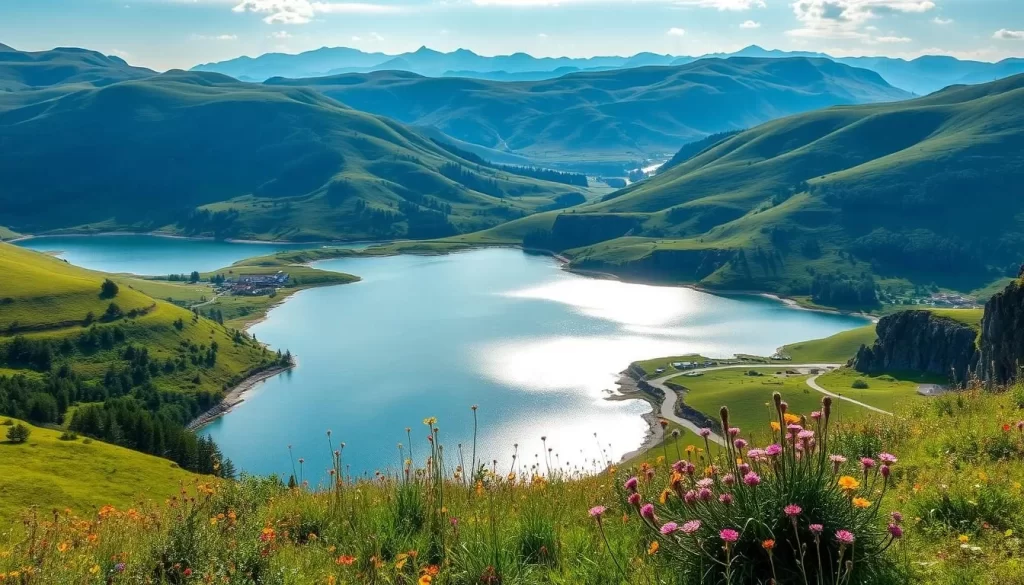
The park’s unique location, where the foothills of the Alps meet the Pannonian plain, creates a diverse and fascinating ecosystem. As a national park, it continues to be a place of interest for both locals and tourists, promoting conservation and appreciation of natural beauty.
The Unique Landscape of Seewinkel
Seewinkel National Park is renowned for its unique landscape, a mosaic of diverse habitats that support a wide range of flora and fauna. This national park is a treasure trove of natural wonders, featuring an array of ecosystems that are rare in Europe.
Lake Neusiedl and Reed Beds
At the heart of Seewinkel lies Lake Neusiedl, a vast, shallow steppe lake surrounded by extensive reed beds that stretch up to 5 kilometers wide. This creates the second-largest reed bed ecosystem in Europe, providing a habitat for numerous species.
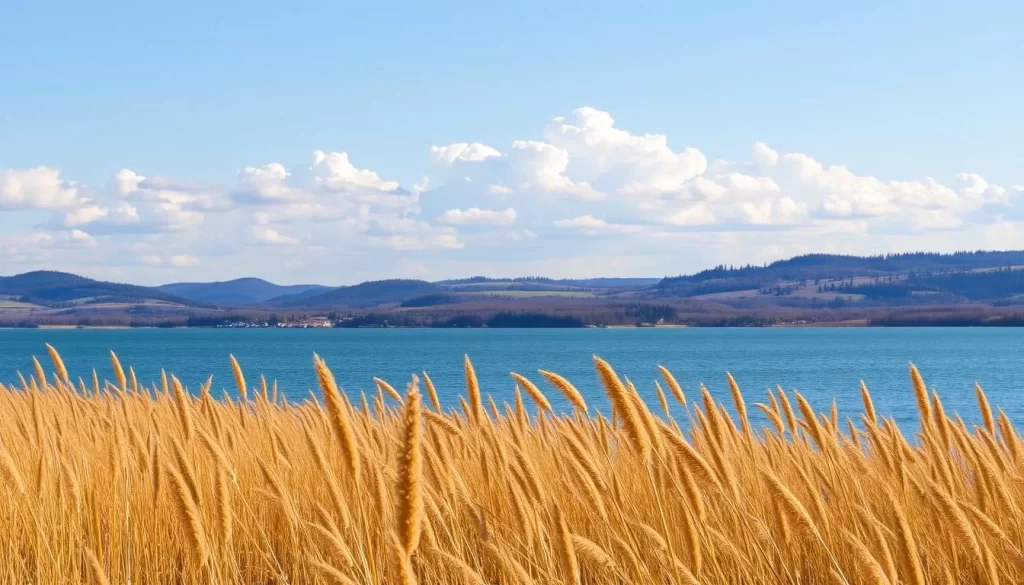
Salt Lakes and Soda Pools
The park is also dotted with unique salt lakes and soda pools, which periodically dry out. These extreme environments support highly specialized plant and animal communities adapted to these conditions, making them a fascinating aspect of the park’s landscape.
Meadows and Pastureland
The meadows and pastureland surrounding the water features add another dimension to the park’s area, creating open spaces that contrast with the reed-dominated lake shores. This diverse landscape mosaic supports an incredible variety of species, many of which are rare or endangered.
Wildlife Watching Opportunities
Seewinkel National Park is a haven for wildlife enthusiasts, offering unparalleled opportunities to observe a diverse range of species in their natural habitats. The park’s varied landscapes support a rich biodiversity, making it an ideal location for wildlife watching.
Bird Migration Spectacle
The park is renowned for its bird migration spectacle, with thousands of birds stopping over during their annual migrations between Europe and Africa. The peak migration periods are in April-May and August-September, making these times ideal for bird watching. You can observe hundreds of species, including rare and impressive birds like great bustards and white-tailed eagles.
Unique Animals: White Donkeys and Grey Cattle
Apart from its avian wonders, Seewinkel National Park is home to unique mammals such as the distinctive white donkeys and Hungarian grey cattle. These animals play a crucial role in maintaining the park’s traditional landscape through their grazing activities.
Best Spots for Wildlife Photography
For wildlife photography, the park offers numerous strategic observation points, including specialized bird hides and observation towers. To capture the best images, plan your visits during early morning or late afternoon when animals are most active and light conditions are optimal.
Top Activities in Seewinkel National Park, Austria: Best Things to Do – Top Picks
Discover the wonders of Seewinkel National Park, Austria, through its exciting activities. The park offers a unique blend of natural beauty and cultural experiences that cater to different interests and preferences.
Horse-Drawn Carriage Tours
Experience Seewinkel National Park in a serene and immersive way with horse-drawn carriage tours. Operators like Vinzenhof Gangl, a third-generation family business, offer guided tours that provide insights into the park’s natural features and cultural heritage.
Horse-drawn carriage tours represent one of the most authentic ways to experience the park, allowing you to travel silently through the landscape.
Hiking and Nature Trails
The park’s well-maintained trail network caters to different fitness levels, offering hiking enthusiasts a chance to explore various habitats and observation points. You can enjoy the park’s nature while getting some exercise.
From short interpretive nature walks to longer routes, there’s a trail for everyone in Seewinkel National Park.
Cycling Around the Park
Cycling is particularly popular in Seewinkel’s flat terrain, with dedicated bike paths that allow you to cover more ground while still observing wildlife. This is a great way to experience the park’s diverse landscapes.
For hiking and cycling, consider combining different activities during your visit for the most rewarding experience in the park.
To make the most of your visit, consider guided tours with park rangers for valuable tips on the ecology and conservation efforts. Seasonal activities vary, offering something new to discover throughout the year.
Lookout Points and Observation Towers
As you explore Seewinkel National Park, you’ll discover numerous lookout points and observation towers that offer breathtaking views of the surrounding landscapes and wildlife. These vantage points are crucial for appreciating the park’s vast, flat terrain and spotting wildlife that might otherwise remain hidden.
Hungarian Watchtower at Sandeck
The Hungarian Watchtower at Sandeck is one of the park’s most iconic structures, offering panoramic views across the border. From this vantage point, you can observe the famous white donkeys and other wildlife in their natural habitat. It’s an ideal spot for bird watching and photography.
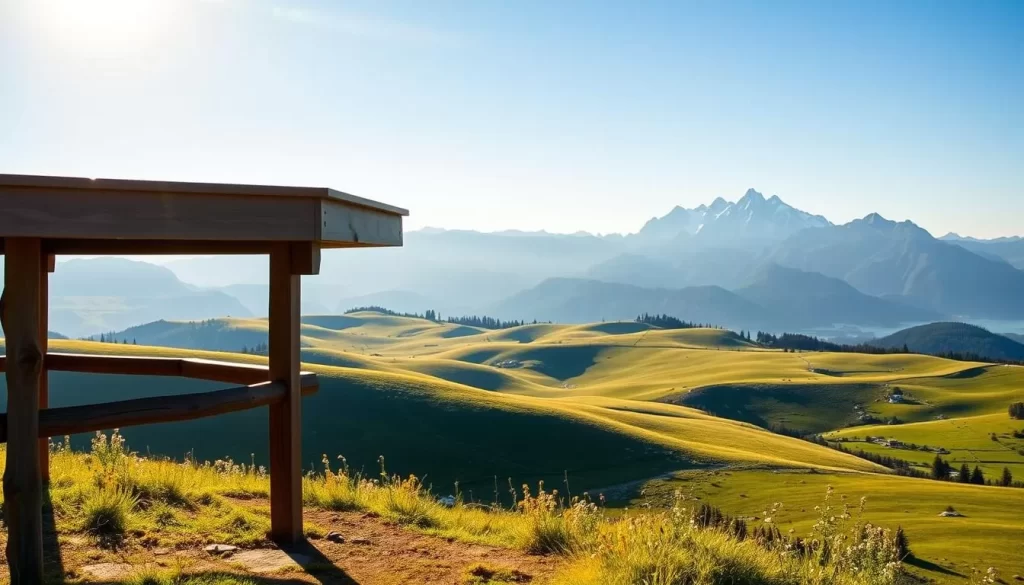
Other Strategic Viewpoints
Another notable viewpoint is the observation tower at Wurbauer Kogel activity center, which provides a comprehensive overview of the park‘s scenery. This makes it an excellent first stop to orient yourself to the national park‘s diverse landscapes. Visiting multiple lookout points during your stay will give you a more complete understanding of this complex ecosystem.
Wine and Culinary Experiences
Beyond its natural wonders, the Neusiedler See-Seewinkel area is celebrated for its wine production and local cuisine, making it a perfect destination for food and wine enthusiasts. You can indulge in the region’s renowned wines and savor local specialties that reflect the area’s unique cultural heritage.
Neusiedlersee Wine Region
The Neusiedlersee wine sub-region, particularly around Seewinkel, is world-famous for its exquisite sweet wines made from botrytis-affected grapes. You’ll find numerous wineries around the lake offering tastings and tours, with the village of Illmitz at the core of the Seewinkel region serving as an excellent base for wine exploration. Top wineries in the area include Weingut Kracher and Weingut Tschida.
Local Gastronomy and Heurige
Local gastronomy perfectly complements the wine experience, with regional specialties that reflect the area’s unique position at the crossroads of Austrian, Hungarian, and Slavic culinary traditions. Traditional “Heurige” (wine taverns) around Lake Neusiedl offer authentic culinary experiences where you can sample new wines alongside homemade specialties. Many establishments emphasize farm-to-table dining, using ingredients produced within the Neusiedler See-Seewinkel National Park area.
Practical Information for Visitors
Getting the most out of your visit to Seewinkel National Park requires some insider knowledge and practical tips. To ensure a smooth and enjoyable experience, it’s crucial to be prepared with the right information.
National Park Information Center
The Neusiedler See-Seewinkel National Park Information Center, located just north of Illmitz, is your essential first stop. Here, you can find comprehensive exhibits about the park’s ecology, detailed maps, and information about guided tours and current wildlife sightings. The knowledgeable staff can help you plan your visit based on your interests and the season.
Getting to Seewinkel National Park
Reaching Seewinkel National Park is straightforward. The most common approach is via Neusiedl am See, which is about an hour’s drive from Vienna on the A4 motorway or accessible by direct train. For the Seewinkel portion, Illmitz is the ideal gateway, accessible by road or a passenger/cycle ferry from Mörbisch am See.
Accommodation Options
You can choose from a range of accommodations around the park, including campgrounds, family-run guesthouses, boutique hotels in wine-growing villages, and wineries like Weingut Kracher that offer excellent lodging. Consider the seasonal highlights when planning your visit: spring and fall for bird migrations, summer for botanical diversity, and winter for large flocks of overwintering geese.
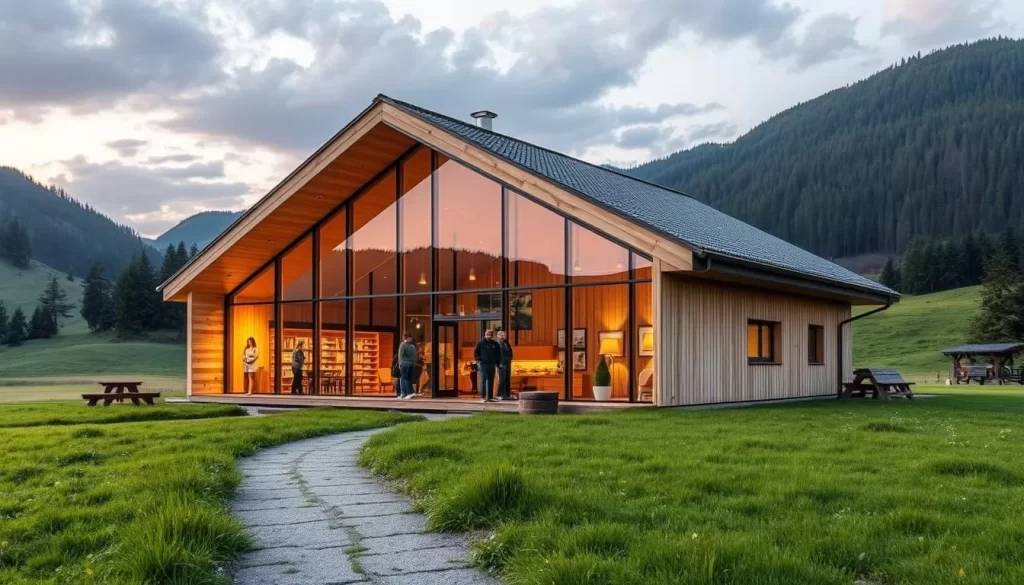
Conclusion: Best Time to Visit and Seasonal Highlights
The beauty of Seewinkel National Park unfolds across the seasons, making it a unique destination at any time of the year. As you plan your visit, consider the distinct experiences each season offers.
Spring (April-May) is a prime time to visit, with peak bird migration and vibrant wildflower displays. In summer (June-August), warmer weather is ideal for cycling and hiking, with early morning or evening visits recommended for optimal wildlife sightings.
Fall (August-September) brings another spectacular bird migration period, along with harvest season in the surrounding vineyards and beautiful autumn colors. Winter offers a serene landscape with large flocks of overwintering geese, creating an unforgettable spectacle. Whatever the season, Seewinkel National Park showcases Austria’s ecological diversity, providing unforgettable nature experiences in this UNESCO World Heritage landscape.
The above is subject to change.
Check back often to TRAVEL.COM for the latest travel tips and deals.
